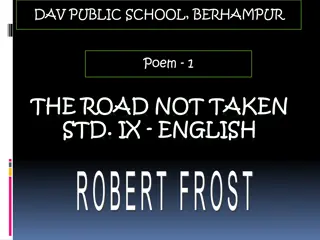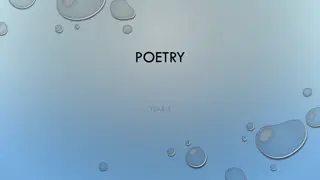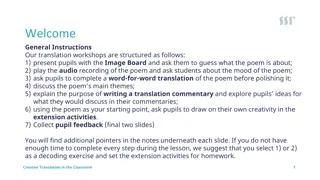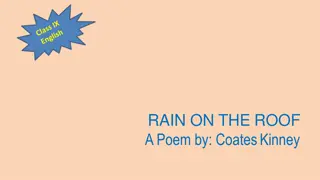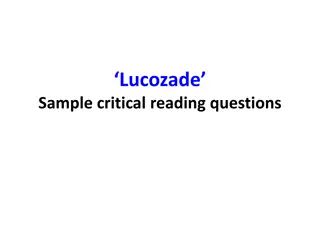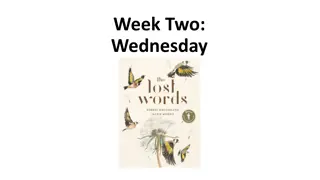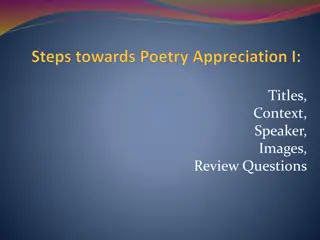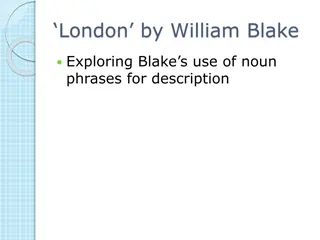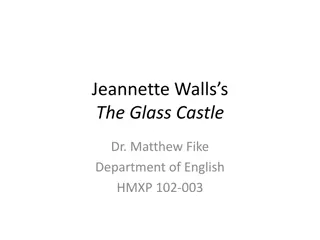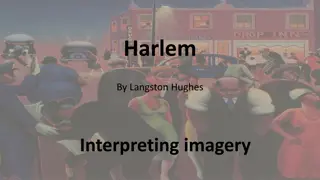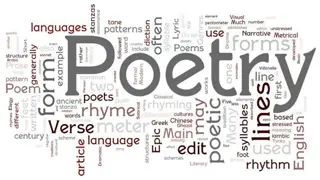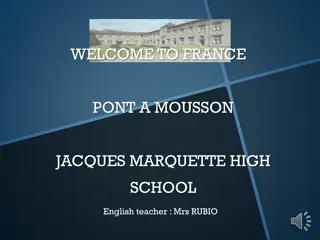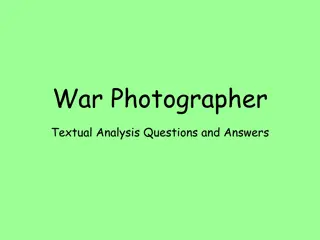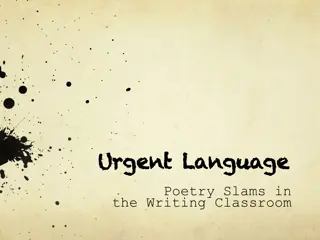Analysis of "The Manhunt" Poem by Simon Armitage
The poem "The Manhunt" by Simon Armitage reveals the emotional journey of a wife as she tries to connect with her physically and emotionally wounded husband, a soldier. Through vivid imagery and powerful metaphors, the poem delves into the complexities of their relationship post-war, highlighting the struggles of understanding and healing. The narrator's quest to explore and unravel the hidden scars of her husband's trauma reflects on the impact of conflict on personal relationships.
Download Presentation

Please find below an Image/Link to download the presentation.
The content on the website is provided AS IS for your information and personal use only. It may not be sold, licensed, or shared on other websites without obtaining consent from the author.If you encounter any issues during the download, it is possible that the publisher has removed the file from their server.
You are allowed to download the files provided on this website for personal or commercial use, subject to the condition that they are used lawfully. All files are the property of their respective owners.
The content on the website is provided AS IS for your information and personal use only. It may not be sold, licensed, or shared on other websites without obtaining consent from the author.
E N D
Presentation Transcript
Eac Each guided poetry lesson will cover a different poem from the 17 in the anthology. It is important to remember that you will NOT be allowed to take your annotated anthology in to the exam.
Poem 1. The Manhunt by Simon Armitage
Only then could I bind the struts and climb the rungs of his broken ribs, After the first phase, after passionate nights and intimate days, and feel the hurt of his grazed heart. only then would he let me trace the frozen river which ran through his face, Skirting along, only then would he let me explore the blown hinge of his lower jaw only then could I picture the scan, the foetus of metal beneath his chest where the bullet had come to rest. and handle and hold the damaged, porcelain collar bone, Then I widened the search, traced the scarring back to its source and mind and attend the fractured rudder of shoulder-blade, to a sweating, unexploded mine buried deep in his mind, around which and finger and thumb the parachute silk of his punctured lung. every nerve in his body had tightened and closed. Then, and only then, did I come close.
AO3 Contextual Introduction. The Manhunt is sometimes referred to as Laura s poem. This is because Simon Armitage wrote the poem for a documentary called Forgotten Heroes: The Not Dead in which the lives of injured returning soldiers was explored. The Manhunt is read by Laura, the wife of Eddie Beddoes, a soldier who served as a peace keeper in Bosnia before being discharged due to injury and depression.
AO1 -What does the second line tell us about the narrator s relationship with the soldier in the hospital bed? AO2 What type of words are passionate and intimate ? How do they help present their relationship? After the first phase, after passionate nights and intimate days, AO1 Why does the narrator say only then , what is stopping her? only then would he let me trace the frozen river which ran through his face, AO1 What does the last line tell you about the soldier s injuries? AO2 The narrator says frozen river , what technique is this and what does she mean?
AO2 What type of word is explore? AO1 What does it tell us about what is happening? AO2 Look at the phrase handle and hold. only then would he let me explore the blown hinge of his lower jaw and handle and hold the damaged, porcelain collar bone, What do these two words tell us about how the narrator is behaving? AO1 and AO2 How are the soldier s injuries described in this section? How do you respond to them? How do they make you feel?
AO1 Think back to handle and hold in the previous section, how does the phrase mind and attend link back to it? AO2 Fractured rudder what is a rudder? What would happen if it was fractured? Why does the narrator use this technique? and mind and attend the fractured rudder of shoulder-blade, AO1 and AO2 and finger and thumb the parachute silk of his punctured lung. Again, think back to handle and hold and mind and attend why does the narrator keep using phrases like this? AO2 The soldier s lung is described as parachute silk , what effect does this have? Why has the narrator chosen this phrase?
STOP! Time to think about AO2 Structure Two line stanzas are called couplets. When thinking about structure, you should ask yourself the following questions: There isn t a regular rhyme scheme, only some couplets rhyme. How are the stanzas ordered? Is there a rhyme scheme? Begins with a memory of their relationship, ends with the reality of their new relationship. How does the poem begin and how does it end? This poem is a lyric poem. A lyric poem is defined as a poem where the narrator reveals strong emotions/thoughts and feelings. What type of poem is it?
AO1 and AO2 The narrator refers to ribs rungs , why does she do this? What techniques is it? AO2 The narrator says bind the struts , what does bind mean? What are its connotations? Only then could I bind the struts and climb the rungs of his broken ribs, and feel the hurt of his grazed heart. AO1 and AO2 Look at the words in the last two lines, which words stand out? Why?
AO1 After looking at the changes to his body, why does the picture of the scan change things? Skirting along, only then could I picture the scan, the foetus of metal beneath his chest where the bullet had come to rest. AO1 and AO2 What are the connotations of the word foetus? What happens when we add the word metal to it? AO2 the bullet had come to rest what technique is this? Why is it used?
AO2 There is a lot of repetition of the S sound in the first few lines. What effect does this create? AO1 Why does the narrator have to widen the search? Then I widened the search, traced the scarring back to its source AO2 What the narrator mean when she uses the metaphor unexploded mine buried deep in his mind? AO1 The narrator says that his nerves have tightened and closed , what does she mean? to a sweating, unexploded mine buried deep in his mind, around which every nerve in his body had tightened and closed. Then, and only then, did I come close. AO1 What does the last line mean? What has she come close to?
AO3 Contextual Reflection. Armitage never served as a soldier, writing poetry was as close as he came to the battlefield. He once said: Never having been to the front line, turning the words, phrases and experiences of these soldiers into verse has been the closest I've ever come to writing real war poetry, and as close as I ever want to get. Why do you think he chose to write about this topic? Why choose a very personal story, rather than one about war in general? Armitage said he wanted to write about the experiences of these soldiers. How has he done that? How do you think Armitage would want the reader to feel after reading this poem?
If you want to analyse the poems yourself, then you could use SPIRIT Key letter: S P I R I T Definition/questions: Structure how are the stanzas ordered? Beginning and end? Poetic devices Enjambment? Repetition? Symbolism? Cacophony? Alliteration? Imagery Similes? Metaphors? Adjectives? Adverbs? Hyperbole? Oxymoron? Contrast? Connotation? Rhythm & Rhyme Can you spot rhythm? Where? When? Why is it used? Same for rhyme Ideas What is the poem about? What does the writer/narrator think and feel? How do you feel? Tone of voice What is the narrator s tone of voice? Is it harsh, or is it sad? Why? What effect does this have?


